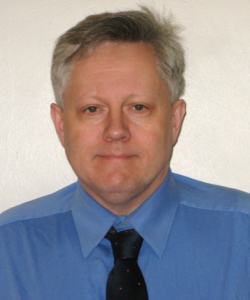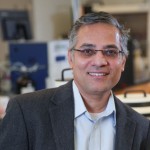
Keith Stine, 2017 Saint Louis Award Winner
Joseph Ackerman, past chair of the St Louis Section–ACS and chair of the St Louis Award jury, has announced the winner of the 2017 St Louis Award.
Dr. Keith J. Stine received his BS degree in chemistry with honors from Fairleigh Dickinson University in Madison, New Jersey in 1984. He carried out undergraduate research in physical organic chemistry with Professor Raymond Baylouny and in computational chemistry with Professor Ronald Strange. He also received a BA degree in Mathematics and Computer Science. He earned his PhD from MIT in 1988, working with Professor Carl W. Garland on studies of phase transitions in liquid crystals. After a postdoctoral position at University of California – Los Angeles studying phase transitions and two-dimensional aggregation behavior in monolayers of surfactants, he joined the Department of Chemistry at University of Missouri – Saint Louis in 1990. He was promoted to Associate Professor in 1996 and to full Professor in 2008. He received the Chancellor’s Award for Service at University of Missouri – Saint Louis in 2009, the Distinguished Service Award of the Saint Louis Section in 2010, and was selected as a Fellow of the American Chemical Society in 2014. He is also a co-author of the most recent edition of the classical text Experiments in Physical Chemistry by Nibler and Garland published in 2014. He recently edited the volume Carbohydrate Nanotechnology published in 2016. He served as Chair of the Saint Louis Section in 2008 and was Secretary of the Local Section from 2002 – 2006. He was the Program Chair for the Midwest Regional Meetings in Saint Louis in 2000 and again in 2011.
His earlier independent work at the University of Missouri-St. Louis was on chiral recognition in monolayers at the water/air interface. This work concerned the supramolecular behavior of long-chain amino acid derivatives at the water/air interface and was the first detailed investigation of chiral separation in racemic mixed monolayers. The work also confirmed the key role of amide-amide hydrogen bonding in chiral recognition in these systems, partly by external reflection infrared spectroscopy in collaboration with Professor Heinrich Hühnerfuss of University of Hamburg, Germany. His group performed some of the earliest studies of surface modification of gold by self-assembled monolayers of synthetic cyclodextrin derivatives in the mid-late 1990s in collaboration with Professor Valerian D’Souza. His more recent work is in collaboration with colleague Professor Alexei Demchenko to introduce nanoporous gold as a potential new nanomaterial on which to develop platforms for supported synthesis of carbohydrates. His lab is also studying independently the fundamental properties of this newly important nanomaterial, and its application as a support for protein assays and separations, with papers appearing in Chemistry of Materials, Nanoscale, Analyst, and New Journal of Chemistry, amongst others. The material, both in thin film and in monolithic form, was found to be suitable for the hosting of enzymes and other biomolecules, for use in separations and in electrochemical biosensor development. By immobilizing antibody-enzyme conjugates, electrochemical sensors for cancer related biomarkers prostate specific antigen and carcinoembryonic antigen were developed. Using lectin-enzyme conjugates, electrochemical sensors for glycoproteins were developed using square wave voltammetry. Nanoporous gold was created in the form of free-standing monoliths and fully surface modified using flow methods. Such monoliths modified with lectins were then shown to be promising for the capture and release of specific glycoproteins from solution.
His research has been funded by the American Chemical Society – Petroleum Research Fund, Office of Naval Research, Department of Defense, National Science Foundation and the National Institutes of Health. He has directed the research of 15 PhD students, 13 MS degree students, about 60 undergraduate students and 12 postdoctoral fellows, some of the latter being jointly with colleagues. He has also directed the research of several visiting students, and 25 high school students including students with NSF and ACS Project SEED support.
The Saint Louis Award, sponsored by the Monsanto Company and administered by the Saint Louis Section–ACS, is presented to an individual who has made outstanding contributions to the profession of chemistry and demonstrated potential to further the advancement of the chemical profession. The award, consisting of a $1,500 honorarium and a plaque, is presented at the Saint Louis Award Banquet that will be held Friday Sept. 29, 2017. Details on the St Louis Award symposium which will also be held that Friday afternoon at the University of Missouri – Saint Louis, can be found here. (Reservations are required for the banquet; see link for RSVP instructions.)


